Revolutionising User Experience: How Mobile and Web Development Are Shaping the Future
Introduction to Revolutionising User Experience (UX)
In today’s digital landscape, user experience (UX) plays a crucial role in the success of Mobile App Development and Web Development projects. Revolutionising UX involves creating intuitive, seamless, and enjoyable experiences for users, which can significantly impact user satisfaction, engagement, and ultimately, business outcomes.
The Importance of User Experience in Mobile and Web Development
User experience is the foundation upon which successful Mobile Applications and Web Applications are built. It encompasses the overall look, feel, and functionality of a digital product, focusing on how users interact with it. A positive user experience can lead to increased user adoption, retention, and positive brand perception.
In the mobile realm, where users have limited screen real estate and shorter attention spans, a well-designed and intuitive UX becomes even more critical. Users expect apps to be responsive, visually appealing, and easy to navigate. Mobile apps with poor UX often lead to frustration and abandonment.
Similarly, in Web Development, users demand fast-loading websites, easy-to-use interfaces, and seamless navigation across devices. With countless options available online, users quickly move on if a website fails to provide a smooth and engaging experience.
Investing in user experience during Mobile App Development and Web Development projects has several benefits. It helps businesses differentiate themselves from competitors, increases user satisfaction, and fosters brand loyalty. By understanding user needs and behaviour, developers can create personalised experiences that cater to specific target audiences.
Moreover, a well-executed user experience can positively impact conversion rates, reduce bounce rates, and encourage users to spend more time engaging with the product or service. It also contributes to higher user retention and increases the likelihood of users recommending the product or service to others.
In summary, user experience is a crucial aspect of Mobile App Development and Web Development that should not be overlooked. By focusing on revolutionising UX, developers can create digital experiences that captivate users, drive business growth, and shape the future of Mobile App and Web development.
The Evolution of Mobile and Web Development
Mobile App Development and Web Development have come a long way since their inception. Initially, websites were designed primarily for desktop computers, and mobile devices were an afterthought. However, with the proliferation of smartphones and tablets, the landscape changed dramatically.
Mobile App Development gained momentum with the introduction of native mobile apps, specifically designed for specific operating systems like iOS and Android. These apps provided a more tailored user experience and took advantage of device-specific features.
Web development also evolved to meet the demands of mobile users. Responsive web design emerged as a solution to create websites that adapt seamlessly to different screen sizes and resolutions. This approach involved using flexible grids, fluid layouts, and media queries to ensure optimal viewing experiences across devices.
As technology advanced, the boundaries between Mobile App Development and Web Development began to blur. The concept of Progressive Web Apps (PWAs) emerged, combining the best of both worlds. PWAs are web applications that leverage modern web technologies to provide a native-like experience, including offline capabilities, push notifications, and home screen installation.
Furthermore, hybrid Mobile App Development frameworks such as React Native and Flutter gained popularity. These frameworks allow developers to build mobile apps using a single codebase that can run on multiple platforms, reducing development time and effort.
The Role of Responsive Design in Enhancing User Experience
Responsive design plays a pivotal role in ensuring a positive user experience across devices. With the wide variety of screen sizes, orientations, and input methods available today, it’s crucial to deliver content in a format that is accessible and visually appealing to all users.
By employing responsive design techniques, websites and applications can dynamically adjust their layout, font sizes, and image sizes to accommodate different screens. This flexibility enables users to access content conveniently, regardless of the device they are using.
Responsive design not only enhances usability but also improves performance. By optimising the rendering of elements based on the device capabilities, websites and apps can load faster and provide a smoother experience, reducing user frustration and abandonment.
Moreover, responsive design contributes to better search engine optimization (SEO) results. Search engines like Google prioritise mobile-friendly websites in their rankings, making it crucial for businesses to ensure their digital presence is responsive.
In summary, responsive design is an essential aspect of modern Mobile App Development and Web Development. By adapting to various devices and screen sizes, it enhances user experience, improves performance, and positively impacts SEO. As the digital landscape continues to evolve, responsive design will remain a fundamental component of creating successful user experiences.
The Impact of Progressive Web Apps (PWAs) on User Experience
Progressive Web Apps (PWAs) have revolutionised the way users interact with websites, providing an enhanced user experience that rivals native mobile applications. PWAs combine the best features of web and mobile apps, delivering fast, reliable, and engaging experiences across devices.
One of the key impacts of PWAs on user experience is their ability to work offline or with a poor internet connection. By utilising caching and service workers, PWAs can store essential assets and data locally, allowing users to access content even when they are offline. This seamless offline capability ensures uninterrupted usage and enhances user satisfaction.
PWAs also offer the advantage of being installable on the user’s home screen, just like a native app. This eliminates the need to search or remember URLs, providing a convenient and familiar way for users to access their favourite websites. Additionally, PWAs can send push notifications, keeping users engaged and informed about updates and relevant information.
Another significant impact of PWAs on user experience is their ability to load quickly, providing instant access to content. PWAs leverage technologies like lazy loading and optimised asset delivery to deliver exceptional performance, reducing bounce rates and improving user retention.
Share your idea or requirement with our experts.
Leveraging Artificial Intelligence (AI) for Personalised User Experiences
Artificial Intelligence (AI) has become a game-changer in the realm of personalised user experiences. By leveraging AI techniques, businesses can gather and analyse vast amounts of user data, enabling them to deliver tailored experiences and recommendations.
AI-powered recommendation engines play a crucial role in personalising user experiences. These engines analyse user behaviour, preferences, and historical data to suggest relevant products, services, or content. By providing personalised recommendations, businesses can improve user engagement, increase conversions, and foster customer loyalty.
AI is also used in chatbots and virtual assistants to provide personalised assistance and support. These AI-driven conversational interfaces can understand user queries, provide relevant information, and even perform actions on behalf of the user. This level of personalization enhances the user experience by offering immediate and targeted assistance.
Moreover, AI enables dynamic content customization based on user preferences. Websites and apps can adapt their content, layout, and design in real-time to match user preferences and optimise engagement. AI algorithms can analyse user interactions and behaviour to deliver personalised content recommendations, creating a more engaging and relevant user experience.
In summary, the impact of PWAs on user experience lies in their ability to provide offline functionality, home screen installation, and fast performance. On the other hand, leveraging AI for personalised user experiences enhances engagement, provides tailored recommendations, and offers dynamic content customization. By embracing these technologies, businesses can deliver exceptional user experiences that cater to individual needs and preferences.
The Influence of Augmented Reality (AR) and Virtual Reality (VR) on UX
Augmented Reality (AR) and Virtual Reality (VR) technologies have made a significant impact on user experience, transforming the way users interact with digital content. AR enhances the real-world environment by overlaying digital elements, while VR immerses users in a simulated digital environment.
AR and VR have the potential to revolutionise various industries, from gaming and entertainment to retail and education. By integrating AR and VR into mobile and web applications, developers can create immersive and engaging experiences that captivate users.
For instance, AR can allow users to visualise products in their real-world environment before making a purchase, providing a more interactive and informed shopping experience. VR can transport users to virtual spaces, enabling them to explore and interact with digital content in a more immersive and realistic manner.
The Role of Voice User Interfaces (VUI) in Mobile and Web Development
Voice User Interfaces (VUIs) have gained prominence in Mobile App Development and Web Development, allowing users to interact with devices and applications using voice commands. VUIs provide a more natural and hands-free way of engaging with digital experiences.
Voice assistants like Siri, Alexa, and Google Assistant have become integral parts of many mobile and smart home devices. They enable users to perform tasks, get information, and control devices by simply speaking commands. VUIs provide convenience, accessibility, and a personalised user experience.
Integrating VUI into mobile and web applications opens up new possibilities for users. Voice commands can be used for tasks such as searching for information, setting reminders, making reservations, and more. VUIs enhance accessibility for users with disabilities and offer a hands-free experience, especially in situations where users cannot interact with a screen.
Designing Intuitive User Interfaces (UI) for Seamless User Experiences
Designing intuitive user interfaces (UI) is crucial for creating seamless user experiences in mobile and web applications. An intuitive UI ensures that users can navigate and interact with the application effortlessly, without confusion or frustration.
To achieve an intuitive UI, designers focus on simplicity, consistency, and clarity. They use familiar design patterns, such as clear navigation menus, recognizable icons, and logical information hierarchy, to guide users through the application. Consistent visual elements and language also contribute to an intuitive UI, making it easier for users to understand and interact with the interface.
Moreover, designers employ user-centred design principles, conducting user research and testing to understand user needs, preferences, and behaviour. This knowledge helps them create interfaces that align with users’ mental models and expectations, enhancing the overall user experience.
Designing intuitive UIs also involves paying attention to usability and accessibility. The interface should be easy to use for users of varying skill levels and should accommodate users with different abilities and devices.
In summary, AR and VR technologies enhance user experiences by providing immersive and interactive digital environments. VUIs offer hands-free and personalised interactions, while intuitive UI designs ensure seamless navigation and interaction in mobile and web applications. By leveraging these elements, developers can create user experiences that are engaging, accessible, and user-friendly.
The Significance of Micro interactions in User Experience Design
Micro interactions are subtle, brief, and often overlooked interactions that occur within a user interface. These small design elements have a significant impact on user experience by providing feedback, guidance, and delight to users.
Micro interactions can take various forms, such as button animations, loading spinners, hover effects, or notifications. They provide visual and auditory cues that inform users about system status, confirm actions, or provide feedback on user inputs.
These small details contribute to a more engaging and intuitive user experience. They create a sense of responsiveness and interactivity, making users feel more connected to the digital product. Well-designed microinteractions can also provide a delightful element that adds personality and charm to the user interface.
Implementing User-Centred Design Principles in Mobile and Web Development
User-centred design (UCD) principles are fundamental to creating successful mobile and web applications. UCD involves placing the needs and goals of users at the centre of the design process, ensuring that the final product meets their expectations and provides a positive user experience.
To implement UCD principles, developers conduct user research to gain insights into user behaviour, preferences, and pain points. This research helps in defining user personas and understanding the target audience’s needs and motivations.
Throughout the development process, designers and developers continuously iterate and test their designs with real users, collecting feedback and making improvements based on user insights. This iterative approach ensures that the final product aligns with user expectations and provides a seamless user experience.
UCD also involves creating intuitive navigation, clear information architecture, and easily discoverable features. Designers focus on simplicity, usability, and accessibility to make the application easy to understand and use for a wide range of users.
The Future of User Experience: Trends and Predictions
The future of user experience (UX) is an exciting and rapidly evolving landscape. Several trends and predictions are shaping the direction of UX design:
/*! elementor - v3.11.5 - 14-03-2023 */.elementor-widget-image{text-align:center}.elementor-widget-image a{display:inline-block}.elementor-widget-image a img[src$=".svg"]{width:48px}.elementor-widget-image img{vertical-align:middle;display:inline-block}
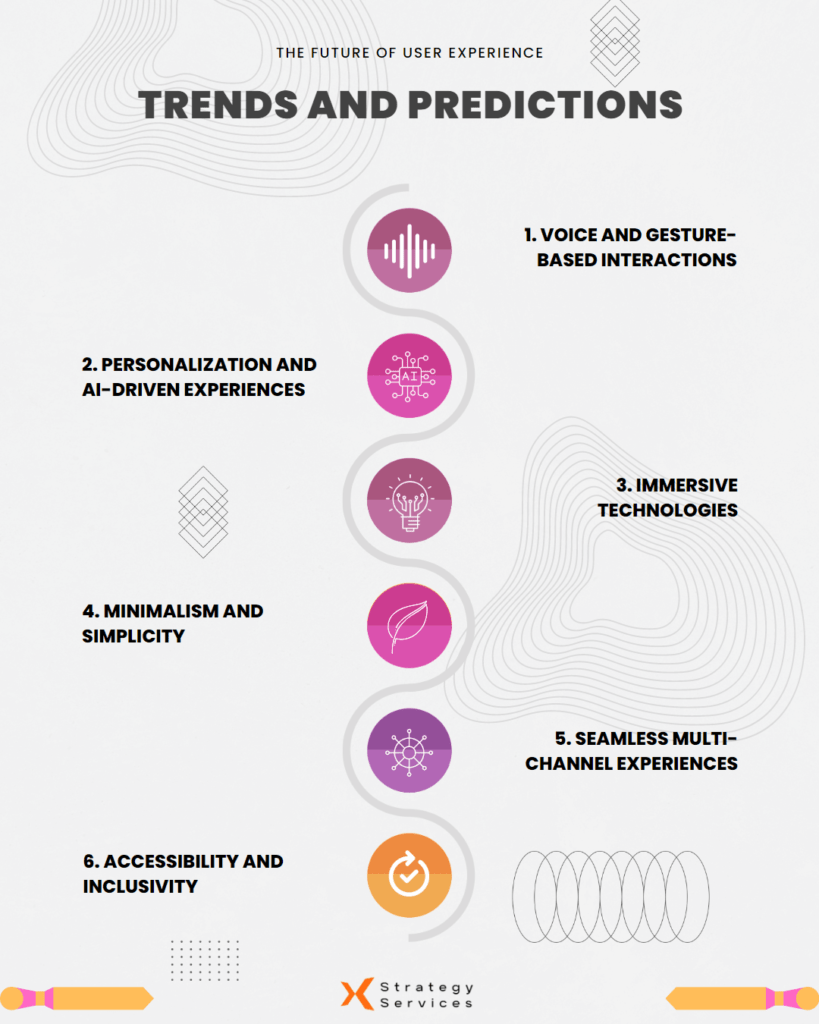
.elementor-heading-title{padding:0;margin:0;line-height:1}.elementor-widget-heading .elementor-heading-title[class*=elementor-size-]>a{color:inherit;font-size:inherit;line-height:inherit}.elementor-widget-heading .elementor-heading-title.elementor-size-small{font-size:15px}.elementor-widget-heading .elementor-heading-title.elementor-size-medium{font-size:19px}.elementor-widget-heading .elementor-heading-title.elementor-size-large{font-size:29px}.elementor-widget-heading .elementor-heading-title.elementor-size-xl{font-size:39px}.elementor-widget-heading .elementor-heading-title.elementor-size-xxl{font-size:59px}
1. Voice and gesture-based interactions
As voice assistants and gesture recognition technologies continue to advance, interactions with digital products will move beyond traditional graphical user interfaces.
2. Personalization and AI-driven experiences
AI algorithms will play a more prominent role in analysing user data and delivering personalised experiences. Users will expect tailored content, recommendations, and interfaces that adapt to their preferences.
3. Immersive technologies
Augmented reality (AR), virtual reality (VR), and mixed reality (MR) will become more prevalent, enabling highly immersive and interactive user experiences across industries like gaming, education, and e-commerce.
4. Minimalism and simplicity
Design trends lean towards minimalistic interfaces with clean aesthetics, emphasising simplicity, clarity, and visual hierarchy to reduce cognitive load and enhance usability.
5. Seamless multi-channel experiences
Users expect a consistent experience across various devices and channels, including mobile, web, wearables, and smart home devices. UX designers will focus on creating seamless transitions and synchronised experiences.
6. Accessibility and inclusivity
Designing for diverse user needs, including accessibility features and inclusive design practices, will become a standard part of UX design to ensure that digital products are usable by everyone.
In summary, the future of UX is characterised by personalised experiences, immersive technologies, simplicity, and inclusivity. By staying up to date with these trends and predictions, UX designers can create forward-thinking and impactful user experiences.
Best Practices for Creating Accessible User Experiences
Creating accessible user experiences is crucial to ensure that digital products are usable and inclusive for all users, regardless of their abilities. Here are some best practices for designing accessible user experiences:
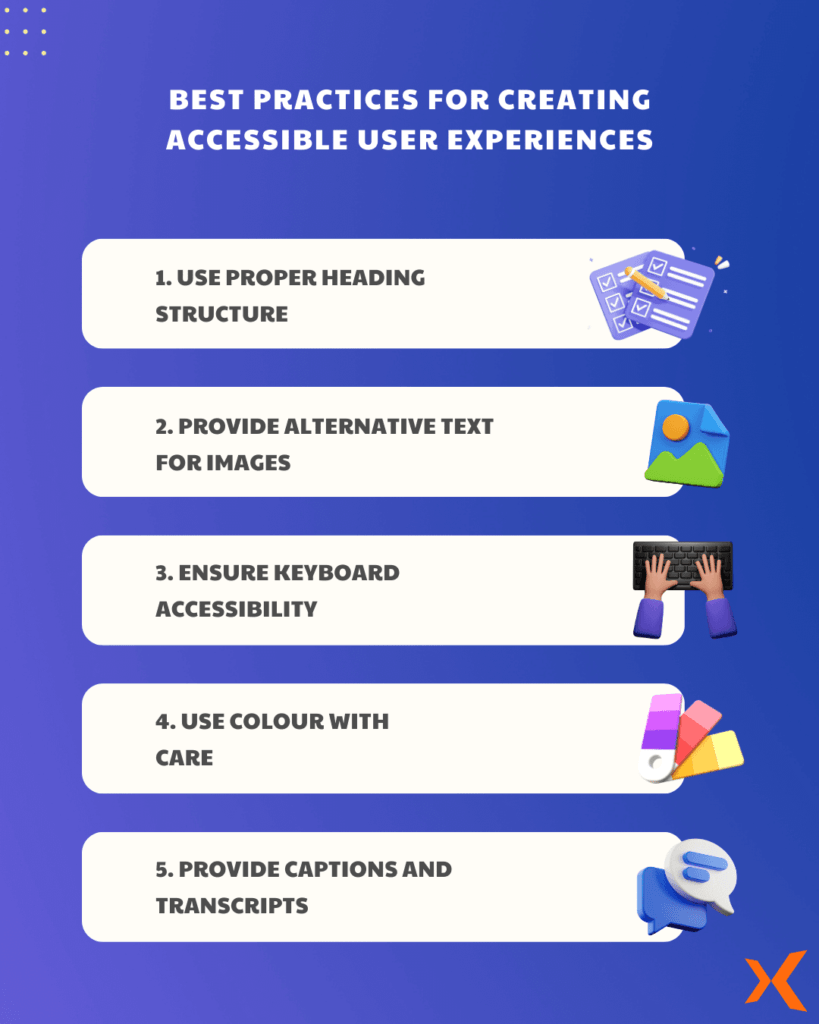
1. Use proper heading structure
Organise content using heading tags (h1, h2, etc.) to create a clear hierarchy. This helps users who rely on screen readers or have cognitive impairments navigate and understand the content.
2. Provide alternative text for images
Include descriptive alternative text (alt text) for images to provide context for visually impaired users. Alt text should be concise and convey the purpose or content of the image.
3. Ensure keyboard accessibility
Design interfaces that can be fully operated using a keyboard alone. This is essential for users who cannot use a mouse or have motor disabilities.
4. Use colour with care
Avoid using colour as the sole means of conveying information. Provide sufficient colour contrast between text and background to make it readable for users with visual impairments.
5. Provide captions and transcripts
Include captions for videos and transcripts for audio content. This benefits users who are deaf or hard of hearing, as well as those who prefer to consume content without sound.
User Experience Testing and Optimization Strategies
User experience testing is essential to ensure that digital products meet user expectations and provide a seamless experience. Here are some strategies for testing and optimising user experiences:
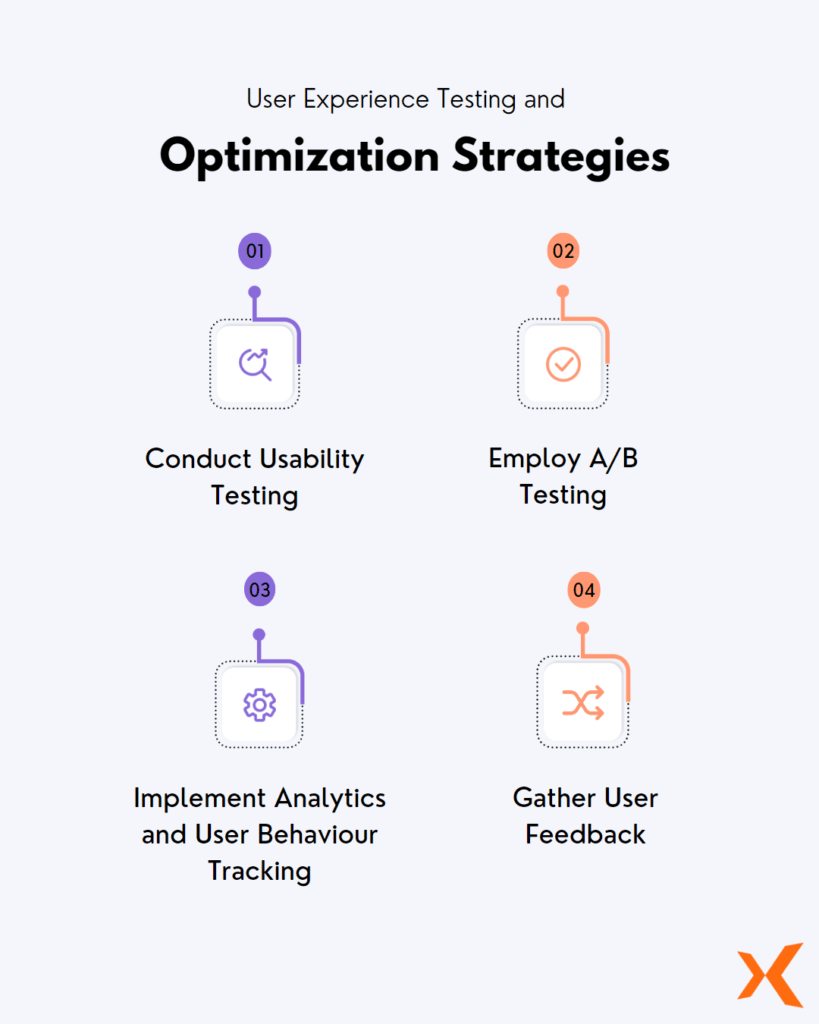
1. Conduct usability testing
Gather feedback from representative users through usability testing sessions. Observe how users interact with the product, identify pain points, and make improvements based on their feedback.
2. Employ A/B testing
Compare different versions of a design element or feature to determine which one performs better in terms of user engagement, conversion rates, or other key metrics. This allows for data-driven decision-making.
3. Implement analytics and user behaviour tracking
Utilise analytics tools to gather data on user behaviour, such as click patterns, navigation paths, and time spent on different pages. This data helps identify areas of improvement and optimization.
4. Gather user feedback
Provide avenues for users to provide feedback, such as feedback forms, surveys, or user ratings. This feedback can provide valuable insights into user preferences and areas for improvement.
The Relationship Between User Experience and User Retention
User experience (UX) and user retention are closely linked. A positive UX can significantly impact user retention rates and foster customer loyalty. Here’s how user experience influences user retention:
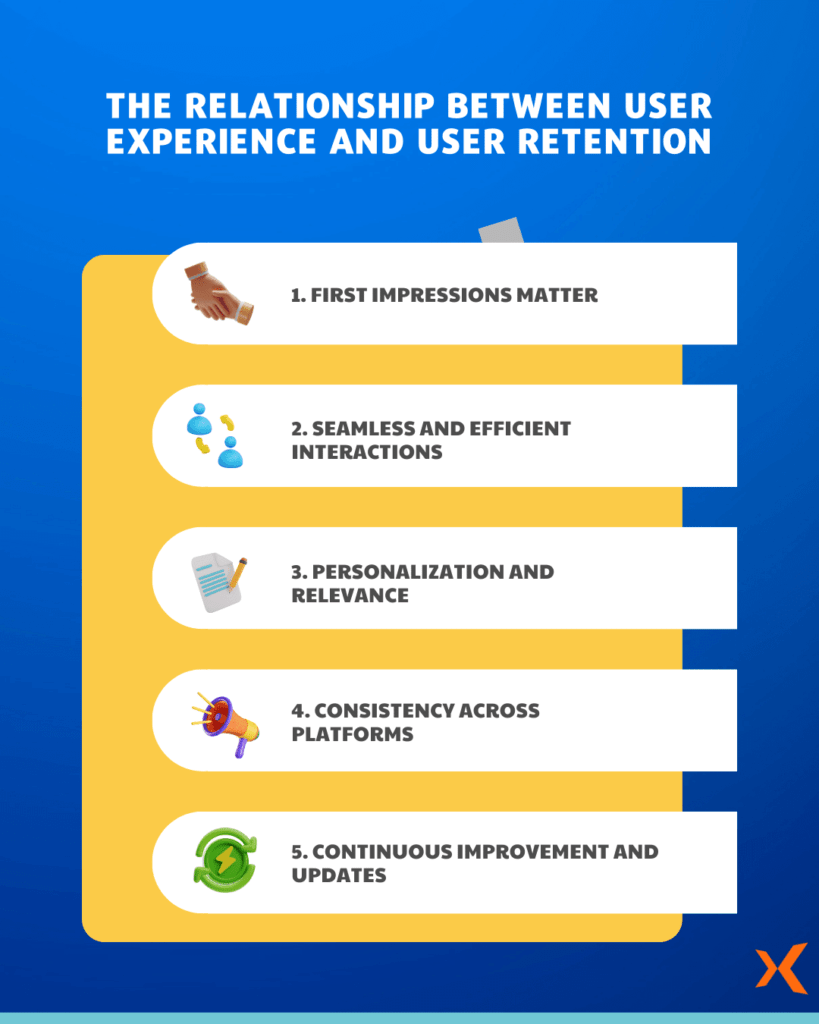
1. First impressions matter
A well-designed and intuitive user experience creates a positive first impression, making users more likely to continue using the product or service.
2. Seamless and efficient interactions
A smooth and effortless user experience reduces friction and frustration. Users are more likely to stay engaged and continue using a product that provides a seamless experience.
3. Personalization and relevance
Tailoring the user experience to individual needs and preferences increases user satisfaction and engagement. When users feel that a product or service understands and meets their specific requirements, they are more likely to remain loyal.
4. Consistency across platforms
Providing a consistent user experience across different platforms and devices fosters familiarity and trust. Users appreciate a seamless transition when using a product on various devices, increasing the likelihood of continued usage.
5. Continuous improvement and updates
Regularly optimising and updating the user experience based on user feedback and evolving needs demonstrates a commitment to providing a high-quality experience. This enhances user satisfaction and encourages retention.
In summary, user experience plays a vital role in user retention. By prioritising usability, personalization, consistency, and continuous improvement, businesses can create user experiences that keep users engaged, satisfied, and loyal over time.
Balancing Functionality and User Experience in Mobile and Web Development
Balancing functionality and user experience is essential in Mobile App Development and Web Development to create successful digital products. While functionality focuses on meeting the needs and objectives of the product, user experience ensures that users can interact with the product effectively and enjoyably.
To strike the right balance, developers must prioritise user-centred design principles. This involves understanding user needs, preferences, and behaviours through user research and incorporating those insights into the development process. Functionality should be designed with the user in mind, ensuring that it aligns with their goals and provides a seamless and intuitive experience.
User feedback and usability testing play a crucial role in achieving the balance between functionality and user experience. By gathering feedback from users and observing their interactions, developers can identify pain points, areas of confusion, and opportunities for improvement. This iterative approach allows for continuous optimization and ensures that both functionality and user experience are prioritised.
Enhancing User Experience through Gamification Techniques
Gamification techniques have become increasingly popular in enhancing user experiences in mobile and web applications. By incorporating game-like elements and mechanics, developers can make interactions more engaging, motivating, and enjoyable for users.
Gamification techniques can include rewards, badges, progress tracking, leaderboards, challenges, and interactive storytelling. These elements tap into users’ intrinsic motivations and desire for achievement, making the experience more immersive and compelling.
Gamification can be applied to various contexts, from Education Apps and Fitness apps to E-commerce Apps and productivity tools. By leveraging game mechanics, developers can increase user engagement, encourage desired behaviours, and create a sense of fun and enjoyment.
The Role of Data Analytics in Improving User Experience
Data analytics plays a vital role in improving user experience by providing valuable insights into user behaviour, preferences, and patterns. By analysing user data, developers and designers can make informed decisions and optimise the user experience accordingly.
Data analytics can help identify usage patterns, user flows, and points of friction within an application. This information enables developers to make data-driven design choices, streamline processes, and remove barriers that hinder the user experience.
Moreover, data analytics can provide insights into user preferences, allowing for personalization and targeted content delivery. By understanding user interests and behaviour, developers can tailor the user experience to individual needs, providing relevant recommendations and customised interfaces.
Data analytics can also assist in identifying areas for improvement and optimising the user experience over time. By tracking key metrics such as user retention, conversion rates, and engagement, developers can measure the impact of design changes and iterate based on data-driven insights.
In summary, balancing functionality and user experience requires a user-centred design approach and continuous optimization based on user feedback. Gamification techniques can enhance user experiences by making interactions more engaging and motivating. Data analytics provides valuable insights into user behaviour, enabling developers to optimise the user experience and personalise interactions.
The Impact of Mobile App Development and Web Development on E-commerce User Experience
Mobile App Development and Web Development have significantly transformed the user experience in the realm of e-commerce. With the rise of smartphones and the increasing prevalence of online shopping, mobile and web platforms have become essential for businesses to engage customers and drive sales.
Mobile App Development has enabled the growth of m-commerce, allowing users to browse, shop, and make purchases directly from their smartphones. Mobile-optimised websites and dedicated mobile apps offer seamless and convenient experiences, with features like mobile-friendly navigation, quick checkout processes, and personalised recommendations.
Web development, on the other hand, has expanded the reach of e-commerce by providing a platform for businesses to establish their online presence. Websites offer a comprehensive shopping experience, incorporating features like product catalogues, search functionalities, user reviews, and secure payment gateways.
The Impact of Mobile App Development and Web Development on e-commerce user experience includes:
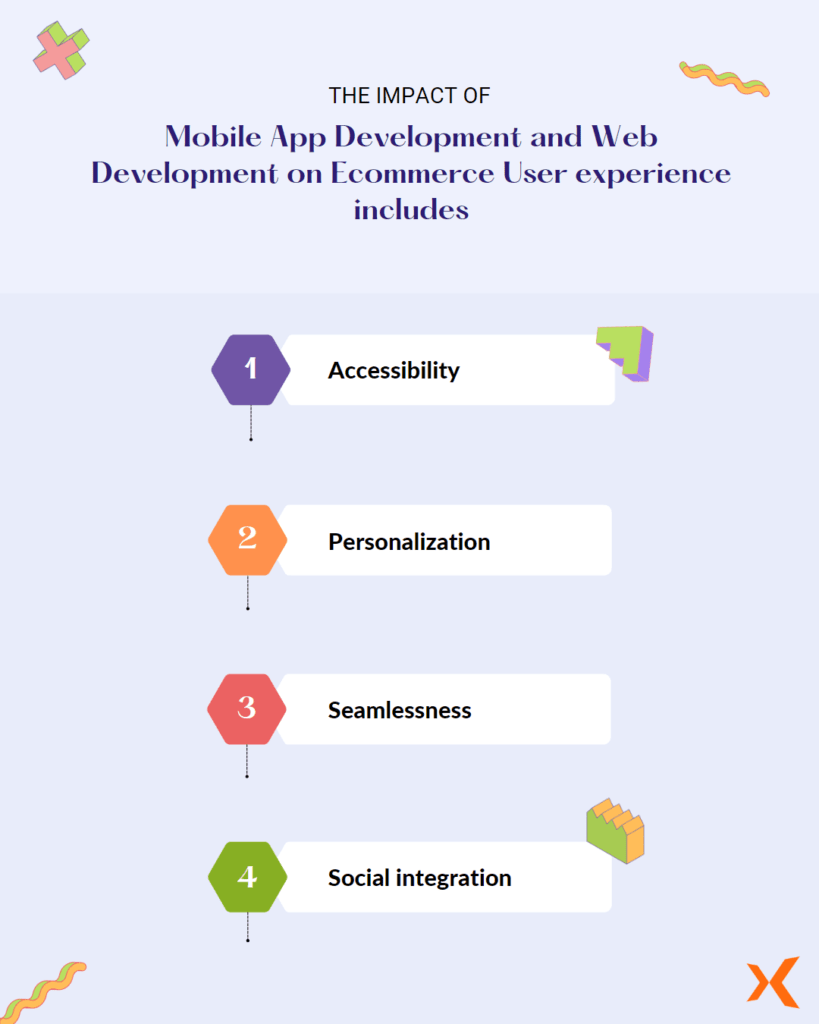
1. Accessibility
Mobile App and web platforms make shopping accessible anytime and anywhere, allowing users to browse and buy products at their convenience.
2. Personalization
Advanced technologies, such as AI and data analytics, enable personalised recommendations based on user preferences, purchase history, and browsing behaviour. This enhances the user experience by presenting relevant and tailored product suggestions.
3. Seamlessness
Mobile App Development and Web Development have optimised the shopping process, minimised steps and streamlining user flows. Features like one-click checkout, saved payment information, and address autofill make the buying experience faster and more convenient.
4. Social integration
Integrating social media platforms into e-commerce websites and apps enables users to share product recommendations, write reviews, and engage with brands. This social integration enhances the user experience by fostering a sense of community and facilitating user-generated content.
Case Studies: Successful User Experience Transformations in Mobile and Web Development
Several case studies highlight successful user experience transformations in Mobile App Development and Web Development. Here are a few examples:
1. Amazon
Amazon’s mobile app and website have undergone significant user experience transformations to become one of the most seamless and user-friendly e-commerce platforms. With features like one-click purchasing, personalised recommendations, and an easy-to-navigate interface, Amazon has set the benchmark for user experience in online shopping.
2. Airbnb
Airbnb revamped its website and mobile app to provide a visually appealing and intuitive user experience. By incorporating high-quality images, simplified search filters, and detailed property listings, Airbnb improved the user journey and made it easier for users to find and book accommodations.
3. Starbucks
Starbucks introduced its mobile app, allowing users to order and pay for their favourite beverages ahead of time. This transformation significantly improved the user experience by reducing waiting times, providing customization options, and offering loyalty rewards, creating a seamless and convenient experience for coffee lovers.
4. Shopify
Shopify offers an e-commerce platform that enables businesses to create and manage their online stores. With a focus on simplicity and ease of use, Shopify provides customizable templates, intuitive store management tools, and robust analytics, empowering businesses to deliver a seamless and engaging user experience.
These case studies demonstrate the importance of Mobile App Development and Web Development in enhancing user experiences and driving business success in the e-commerce industry.
Why Choose X-Strategy Services LLP for Revolutionising User Experience
When it comes to revolutionising user experience and staying ahead in the rapidly evolving landscape of mobile and web development, X-Strategy Services LLP stands out as an excellent choice. Here are the reasons why you should choose X-Strategy Services LLP for transforming user experience and embracing the future of mobile and web development:
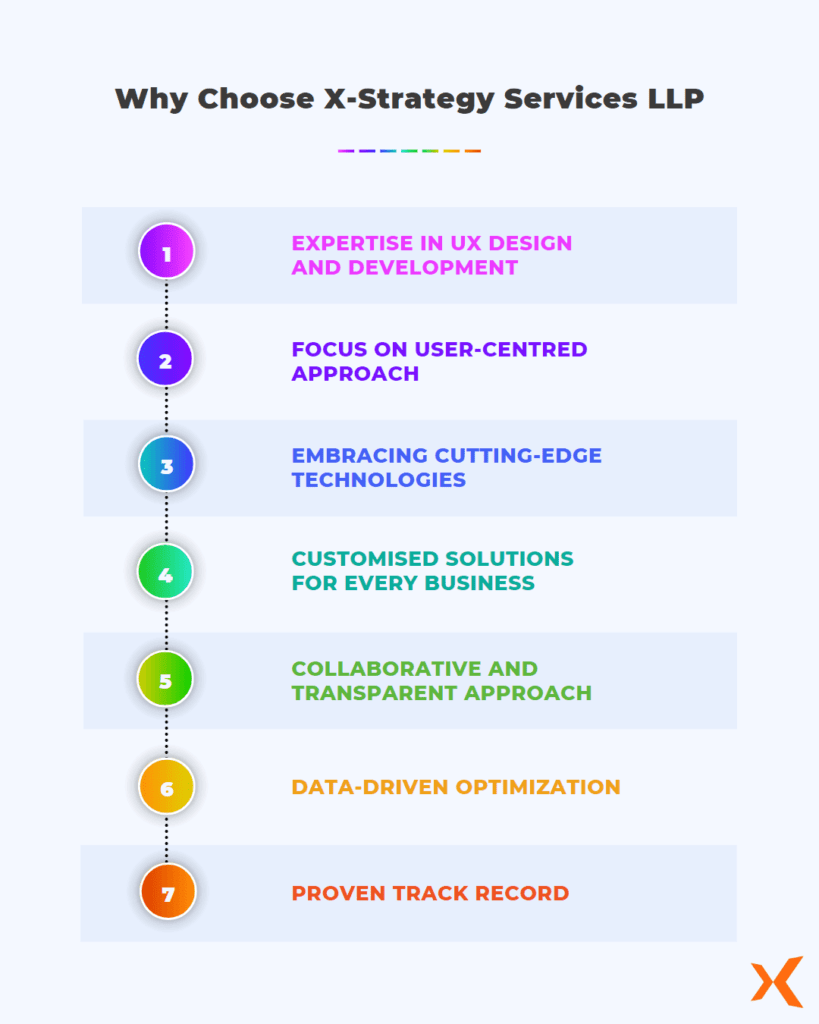
1. Expertise in UX Design and Development
X-Strategy Services LLP boasts a team of highly skilled and experienced professionals specialising in UX design and development. They understand the latest trends, best practices, and emerging technologies that shape the future of user experience, ensuring that your products stay relevant and engaging.
2. Focus on User-Centred Approach
X-Strategy Services LLP puts users at the heart of their design and development process. They conduct thorough user research, analyse user behaviour, and gather insights to create intuitive, user-friendly interfaces that align with the expectations and needs of your target audience.
3. Embracing Cutting-Edge Technologies
X-Strategy Services LLP keeps a pulse on the latest advancements in mobile and web development. They leverage emerging technologies like AI, AR/VR, and voice interfaces to create immersive and innovative user experiences that captivate and engage users.
4. Customised Solutions for Every Business
X-Strategy Services LLP understands that every business is unique with its own set of challenges and goals. They tailor their services to meet your specific requirements, providing customised solutions that align with your brand identity, target audience, and industry.
5. Collaborative and Transparent Approach
X-Strategy Services LLP values collaboration and open communication. They involve you in the design and development process, seeking your input and feedback at every stage. Their transparent approach ensures that you are informed and involved in shaping the user experience of your products.
6. Data-Driven Optimization
X-Strategy Services LLP believes in the power of data to drive continuous improvement. They utilise analytics and user feedback to measure the effectiveness of their designs, identify areas for optimization, and make data-driven decisions to enhance the user experience.
7. Proven Track Record
X-Strategy Services LLP has a track record of delivering successful projects and transforming user experiences for clients across various industries. Their portfolio showcases their expertise and demonstrates their ability to create impactful and user-centric solutions.
In conclusion, X-Strategy Services LLP is the ideal partner for revolutionising user experience in the mobile and web development space. With their expertise, user-centred approach, cutting-edge technologies, customization, collaboration, data-driven optimization, and proven track record, X-Strategy Services LLP is well-equipped to shape the future of user experience and help your business thrive in the digital landscape.


